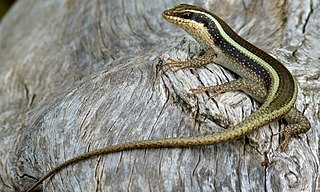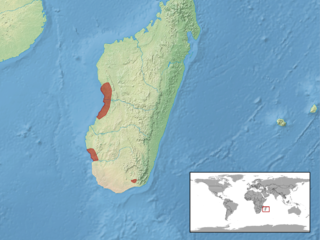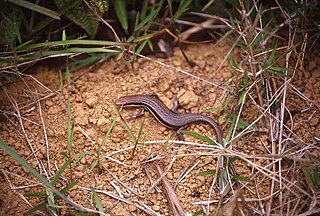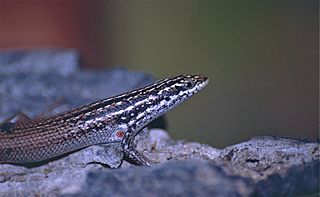Euprepis is an obsolete genus of skinks in the subfamily Lygosominae. It was named by Wagler in 1830 and frequently used in subsequent years, often misspelled as Euprepes, a misspelling introduced by Wiegmann in 1834. It was then subsumed under the large skink genus Mabuya, until Mausfeld and others resurrected it for a group of mainly African skinks they split from Mabuya. The following year, Bauer argued that this assignment had been in error and that this group should be called Trachylepis instead. Euprepis itself is a junior synonym of Mabuya.

Trachylepis is a skink genus in the subfamily Mabuyinae found mainly in Africa. Its members were formerly included in the "wastebin taxon" Mabuya, and for some time in Euprepis. As defined today, Trachylepis contains the clade of Afro-Malagasy mabuyas. The genus also contains a species from the Brazilian island of Fernando de Noronha, T. atlantica, and may occur in mainland South America with Trachylepis tschudii and Trachylepis maculata, both poorly known and enigmatic. The ancestors of T. atlantica are believed to have rafted across the Atlantic from Africa during the last 9 million years.

Wright's skink, also known commonly as Wright's mabuya, is a species of lizard in the family Scincidae. The species is endemic to Seychelles. There are two recognized subspecies.

The African striped skink, commonly called the striped skink, is a species of lizard in the skink family (Scincidae). The species is widespread in East Africa and Southern Africa. It is not a close relation to the Australian striped skink, Ctenotus taeniolatus.

The Noronha skink is a species of skink from the island of Fernando de Noronha off northeastern Brazil. It is covered with dark and light spots on the upperparts and is usually about 7 to 10 cm in length. The tail is long and muscular, but breaks off easily. Very common throughout Fernando de Noronha, it is an opportunistic feeder, eating both insects and plant material, including nectar from the Erythrina velutina tree, as well as other material ranging from cookie crumbs to eggs of its own species. Introduced predators such as feral cats prey on it and several parasitic worms infect it.
Under the International Code of Zoological Nomenclature (Code), the name-bearing type is the biological type that determines the application of a name. Each animal taxon regulated by the Code at least potentially has a name-bearing type. The name-bearing type can be either a type genus, type species, or one or more type specimens. For example, the name Mabuya maculata has often been used for the Noronha skink, but because the name-bearing type of the former, a lizard preserved in the Muséum national d'histoire naturelle in Paris, does not represent the same species as the Noronha skink, the name maculata cannot be used for the latter.
Trachylepis tschudii is an enigmatic skink, purportedly from Peru. First described in 1845 on the basis of a single specimen, it may be the same as the Noronha skink (T. atlantica) from Fernando de Noronha, off northeastern Brazil. T. tschudii represents one of two doubtful records of the otherwise African genus Trachylepis on mainland South America; the other is T. maculata from Guyana.

Trachylepis capensis is a species of skink, a lizard in the family Scincidae. The species is native to southern Africa.
Trachylepis bayonii, also known commonly as Bayão's skink, Bayon's mabuya, and Bayon's skink, is a species of lizard in the family Scincidae. The species is endemic to Africa. There are two subspecies.
Trachylepis rodenburgi, also known commonly as Rodenburg's mabuya, is a species of skink, a lizard in the family Scincidae. The species is endemic to West Africa.

Trachylepis boettgeri, commonly known as Boettger's mabuya, is a species of skink, a lizard in the family Scincidae. The species is endemic to Madagascar.

Benson's mabuya is a species of skink, a lizard in the family Scincidae. The species is native to Western Africa.

Trachylepis bocagii, also known commonly as Bocage's skink, is a species of lizard in the family Scincidae. The species is native to southern Africa.
Trachylepis boulengeri, also known commonly as Boulenger's mabuya, is a species of skink, a lizard in the family Scincidae. The species is indigenous to southeastern Africa.
Trachylepis buettneri is a species of skink, a lizard in the family Scincidae. The species is native to Central Africa and West Africa.

Trachylepis dumasi is a species of skink, a lizard in the family Scincidae. The species is endemic to Madagascar.

Trachylepis gravenhorstii, also known commonly as Gravenhorst's mabuya, is a species of skink, a lizard in the family Scincidae. The species is endemic to Madagascar.
Trachylepis hoeschi, also known commonly as Hoesch's mabuya and Hoesch's skink, is a species of lizard in the family Scincidae. The species is native to southwestern Africa.

Trachylepis nancycoutuae, also known commonly as Nancy Coutu's mabuya and Nancy Coutu's skink, is a species of lizard in the family Scincidae. The species is endemic to Madagascar.

Trachylepis perrotetii, also known commonly as the African red-sided skink, the red-sided skink, and the Teita mabuya, is a species of lizard in the family Scincidae. The species is endemic to Africa.












